Anatolian Guardian Behavior
Desirable Working Traits in Anatolians
|
Desirable Working Traits in Anatolians by Erick Conard February 15, 2021 of LUCKY HIT RANCH 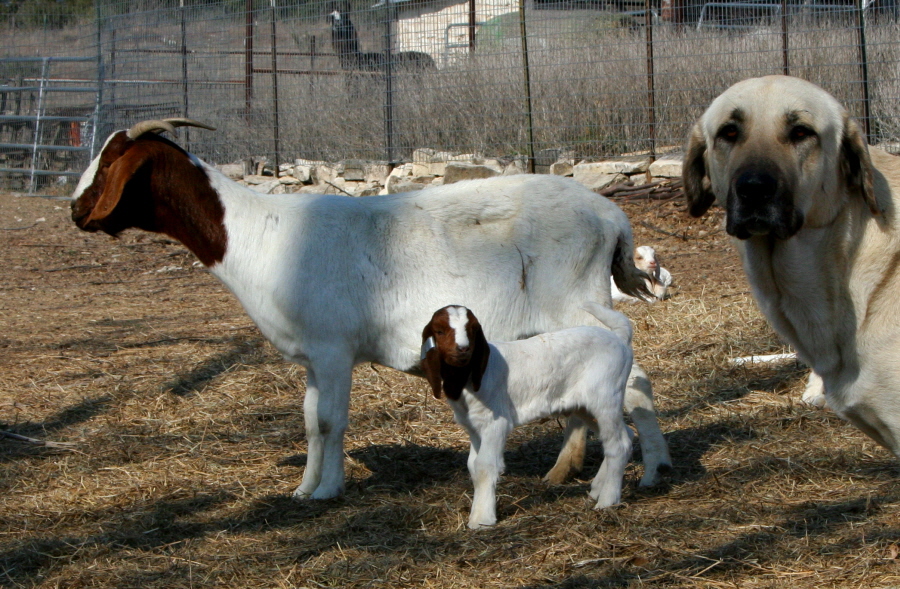 LUCKY HIT'S Shadow BENEK (BENEK) BENEK possessed incredible Working ability and Deep Love for her goats. She did not care much for people - an excellent working trait! 1. HUMAN PREDATORS Animal predators are not the only predator an Anatolian is required to guard against. Humans might try to steal the sheep and/or goats and so the Anatolian is required to protect their animals from human predators. In guarding against humans, an EXCELLENT working Anatolian generally exhibits such an aggressive display that a total stranger feels too threatened to enter the property much less pick up a sheep or goat and attempt to leave with it. Protection against humans is also necessary when a human becomes aggressive toward an Anatolian's owner. This protection is offered only if the owner has done the work to develop the proper relationship with their Anatolian and the Anatolian has been correctly selected and bred for superior working ability. An excellent example of this protection occurred here at Lucky Hit Ranch. I hired a crew to put up a fence creating a lane through one of my pastures. I had several dogs in that pasture and indicated to my dogs that the men working on the fence were OK. My dogs trusted my assessment but were watchful. My eight month old female, LUCKY HIT Sonra Cas Kizzie of Cedar Rise (CAS), was watching me from beneath a storage building about 100 feet from where I was standing. I asked a worker to pick up the fence stretcher, a four foot 2x4 with steel clamped on it. As he picked it up, I turned around. He held it like a club. CAS leaped out from under the storage building, running to me. As she passed the man, she clipped his leg with her chest, causing him to spin slightly away and drop the 2x4. (I want an Anatolian who initially employes non-biting methods for my protection. Excellent protective responses are instilled genetically and must be considered in all breedings.) CAS passed the man without pausing and whirled around in front of me, taking a defensive posture while snarling and barking a warning for the man to stop his aggression. The man stood frozen in place; he was terrified. I reached down, patting CAS'S rump, and told her it was OK in a calm, soothing voice. Seeing he was completely submissive in addition to my reassurances, CAS immediately stopped her aggressive display. All of this protective behavior occurred without training of any kind, another demonstration indicating how important it is to carefully select breeding Anatolians for correct genetically instilled Anatolian behaviors rather that the artifical behaviors selected for in the show ring. CAS remained relatively close to me the rest of the day in case someone else decided to pick up a club to hit me over the back of the head!!! Having a wonderful and powerful dog use such excellent judgement and control obtained from selecting for correct working ability rather than any form of protection training allows me to feel completely safe and totally protected! Another situation can occur if the person is someone that the Anatolian has been introduced to briefly, but someone the Anatolian doesn't believe is entitled free access to their owner's property, an EXCELLENT Anatolian might allow the person on the property without friendliness, but not too threatening either. Once on the property, the Anatolian holds the person in place (frequently against a fence or wall) until the owner returns and provides the Anatolian guidance. During this time, if the person tries to move, the Anatolian growls and is quite threatening! Believe the Anatolian. It is not a bluff!!! Another situation can occur when a stranger approaches the gate and the Anatolian is scary and aggressive. When the owner hears the uproar and reaches the gate, the Anatolian continues its display until the owner speaks nicely with the stranger. The well-bred and trained Anatolian understands the friendly interaction and stops their display. The stranger is then allowed to enter through the gate. The Anatolian is polite, although in some cases suspicious, as long as the person remains polite and without any aggression in their voice, body language, or actions. Only twice in thrity-five years have I had an Anatolian fail to calm down when I spoke nicely to the stranger. In those two cases, I trusted my Anatolians and didn't allow the person through the gate. 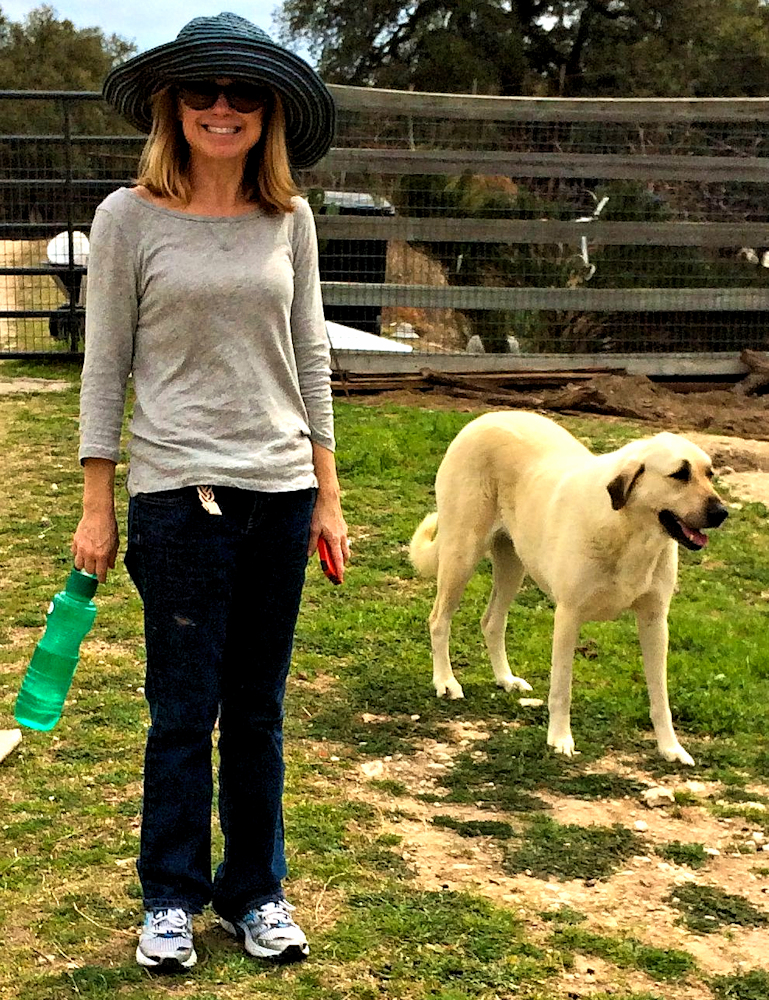 CHAMPION Innana BETHANY Bay of LUCKY HIT showing a calm and pleasant demeanor after I allowed a new person, "Katherine," on the property on February 20, 2015. Notice that Katherine is displaying an agreeable and non-threatening demeanor with her arms down at her side! BETHANY sees this non-aggressive stance and is reassured that all is well with this new person I've allowed on the property. Sometimes a stranger approaches the gate and stops about twenty feet away in response to the Anatolian's clear warning. Although the Anatolian most probably presented an initial display of aggression, as long as the person is non-threatening, remains far enough back from the property, and doesn't appear to be attempting entry to the property, the Anatolian may decide to stop barking and lay down and watch. But if the person decides to enter and approaches the gate, the threat displays will begin again. Excellent judgement regarding a stranger and a stranger's unusual behavior is also important. For instance, a work friend made a visit to Lucky Hit Ranch some years ago. He loved seeing my animals and was readily accepted by my dogs when introduced. I had lots of chores and he started helping me. I gave him a bucket of feed and mentioned he needed to hold the bucket up high or the goats would get it. He didn't hold it high enough, so a couple of goats jumped up and pushed their heads in the bucket, pulling him over and to the ground. He was a large and very powerful man so I was surprised to see him pulled under a swarm of goats intent on grabbing some of the spilled grain. LUCKY HIT'S Tawny SHADOW (SHADOW) had been accompanying him (mostly to keep an eye on the "stranger") so when I saw her leap across the backs of the rampaging goats and straddle his body I was a bit apprehensive. "Is she going to punish him for yelling and kicking her goats?" I didn't need to worry! SHADOW understood the situation for what it was! She snarl-barked, clacking her teeth and swinging her head, protecting my friend from the trampling goats. Goats melted away like magic! My friend jumped up and moved away with Shadow protectively beside him. Sometimes I'm amazed how brilliantly a superior working Anatolian can evaulate a situation. She knew my friend was in trouble and even though it was with her goats, she ordered them back to allow him to get up rather than be trampled. 2. ANIMAL PREDATORS The single most important trait required in excellent Anatolian guardians is that they meet aggression with greater aggression and do not give up and allow a predator to kill their charges. Some years ago I read an interesting article translated from an interview with a Turkish shepherd. He stated that protecting the sheep and/or goats was the dog's job, not his. His job was to evaluate the the dog! If the Anatolian saw the overwhelming power of the predators and turned and ran, the shepherd killed that dog that day. (Killing is NOT appropriate here!!! Turkish shepherds lived at a subsistence level and couldn't afford feed a dog unable or unwilling to protest the flock. If we don't believe a dog should pass on its genetics, neutering or spaying is our option!) As Turkish shepherds knew, one must observe an Anatolian in a working setting with serious predators to actually understand an Anatolian's true level of working ability and dedication to its charges! By raising Anatolians in a true working enviornment (with sheep and/or goats in a predator rich environment), a breeder has the opportunity to discover the depth of dedication their dogs have to protecting their animals. The picture below shows a healing male mountain lion bite on the leg of LUCKY HIT'S Tawny SHADOW (SHADOW), a LUCKY HIT Foundation Female. 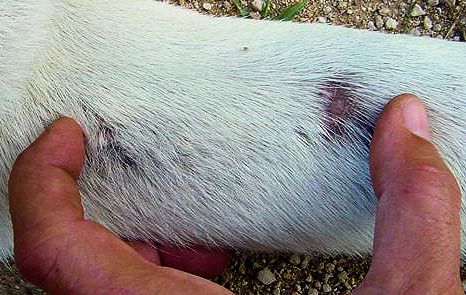
Pictured above on August 12, 2003, is SHADOW's left fore arm showing the width of the MOUNTAIN LION BITE The hairless spots show where its fangs pierced her leg in early July, 2003. The bite was deep and took a great deal of time to heal! There were a total of five Anatolians in the pasture, including Shadow. The other four were LUCKY HIT Shadow Kasif (CASE), LUCKY HIT Shadow Tokat (TOKAT), CHAMPION Birinci's YASHI of LUCKY HIT (YAHSI), and LUCKY HIT Shadow Seven (SEVEN). Tokat had a severe injury to his front leg and had his side torn open by three claws. Seven was hit in the rear end and had an injury there. Yahsi and Case, both extremely powerful and agile, were uninjured. The only adult in the group was Shadow. Yahsi was the youngest pup (under a year) and the other three were littermates and older pups! My Anatolians protected the goats and kids in their pasture and severely injured the male cougar before it made it over the pasture fence. Aware of how dangerous the cougar was to their flock, they dug under the fence and finished it off a short distance away in my neighbor's section pasture. All my Anatolians remained on high alert for weeks afterwards! As dangerous as cougars are, I find that the viscious PIG PACKS propagating throughout the area are even more dangerous!!! My initial experience with pig packs took place in the late 1990's. I sold Conard Farm and all of my smaller animals. I leased 40 acres fenced with a very old, rusted four strand barbed wire fence and moved my horses, Simmenthal cows, and llamas there while I searched for new property. The leased pasture was in a very remote area and I trusted my Anatolian, CONARD'S TAWNY KAT (TAWNY), dam of LUCKY HIT'S Tawny SHADOW (SHADOW), to stay with her animals, even though I'd sold her sheep and goats. (I WOULD NEVER USE SUCH HORRIBLE FENCING FOR ANATOLIANS AGAIN!) I admit I did feel a bit scared when I drove her over in the stock trailer with the llamas (her good buds) and then turned them all out. Every Anatolian I have goes back to this female. She watched as I drove off, positioning herself with the llamas. The next day I was relieved to see her jump up from her position with the llamas and run to greet me. She always made me feel special because she had no interest in anyone but me! It took about six months to find Lucky Hit Ranch and then another three months of negotiation. All that time TAWNY remained on the leased forty acres. I'd noticed that all the ranchers around there kept cattle with long vicious horns and couldn't imagine why anyone wanted cows with such dangerous head gear! My Simmenthal were all dehorned. After Lucky Hit Ranch was mine, I moved TAWNY and the llamas first. In preparation for the move, I took TAWNY with me to Lucky Hit three times. Each time, we walked around the property and TAWNY seemed to enjoy it as much as I did. She especially loved the spring fed creek running through the center of Lucky Hit. The fence wasn't in good shape but I wanted to get my animals on my own property as quickly as possible. Luckily, TAWNY had the desireable FOLLOWING INSTINCT and didn't go far from her core animals. The Following Instinct is a working trait that is being lost to the breed because the way many breeding Anatolians are being maintained doesn't allow for the owner to see whether or not their dogs have the Following Instinct. (You have to have your Anatolians with sheep and/or goats [and in a pinch, TAWNY was happy with llamas] on sufficient acreage and surrounded by serious predators to understand the extent your Anatolians have the Following Instinct!) A few days after TAWNY and my llamas had been moved I dropped by the leased forty acres to check on the cows and horses. A couple of the young Simmental calves were missing. I immediately realized that by removing TAWNY I had allowed the remaining animals to be at risk. While TAWNY was present, all the animals were fine. I decided to immediately move all the animals to Lucky Hit Ranch so they were protected. Early that next morning, I pulled onto the leased property with my stock trailer to be confronted by a devastating slaughter! The horses were head high, running wild, and terrifed, startled whenever the wind blew through the branches! A pregnant 1,400 pound Simmenthal cow was dead and gutted. Her calf had been eaten, probably as she lay helpless in labor. Several more calves were also missing! Pig tracks were everywhere! I now understood why the ranchers here only kept cows with long dangerous horns. It was the only way they could keep their cows alive!!! And TAWNY had kept all this slaughter and devastation at bay by herself! ONE ANATOLIAN!!! ALONE!! All responsible breeders need to keep in mind that working ability requires an Anatolian possesses the internal strength and power to stand alone against overwhelming odds to protect their flock!!! A dog that allows their animals to be killed to ensure their own safety is not a guardian! No show ring is able to reveal whether or not an Anatolian possesses this crucial guardian ability! And only Anatolians with correct working ability and structure can stand against a large pig pack (or other serious and agile predators) without being killed in the process for their lack of speed, agility, muscular strength, and internal protective power! As were many of the early Anatolians, Tawny was a moderately sized Anatolian weighing around 100 pounds. Excessively large Anatolians can lose speed and agility and tire more quickly, which is why I value the size range for Anatolians set down in the AKC Anatolian Standard! 2.5 SUSPICION OF STRANGERS, STRANGE DOGS, STRANGE SITUATIONS SUSPICION of all thing different goes hand in hand with both "Human Predators" and "Animal Predators." Far too many of todays Anatolians accept strangers, even on their own property! Anatolians should never immediately accept strangers on their own property. Watchful suspicion, like that seen (and described above) by LUCKY HIT Sonra Cas Kizzie of Cedar Rise (CAS), is what I believe to be the perfect level of cautious watchfulness with the internal strength to correctly stop problems as they come up. Cautious watchfulness and the strength to protect when necessary are essential elements in a true guardian Anatolian. A well-known working Anatolian breeder told me, with much concern "I've been to so many farms where the Anatolians readily allow me into their pastures. I could steal whatever stock I wanted! I could probably even steal the dog!!" I believe this inappropriate acceptance of all things strange is the result of show breeders who have decided to breed for what helps them win in the ring rather than breeding for Breed Preservation (ie, working ability). This is also a sad statement regarding many AKC judges' failure to understand correct demeanor and behavior of Anatolians bred correctly for Breed Preservation. The lack of cautious watchfulness and mistrust of strangers and strange situations is an even more serious indictment for those Anatolian "Breeders" who are breeding against this correct behavioral response in Anatolians. Even if the "breeder" is unwilling or unable to test their breeding Anatolians for correct working ability, they can determine whether or not their Anatolians have a correctly suspicious nature. I can't help but believe their choice to breed for incorrectly accepting Anatolians is directly related to their desire to win in the ring! To me, this type of breeder can ultimately contribute to the ruination of the breed and should NEVER be considered a BREED PRESERVATIONIST! NO CORRECTLY BRED ANATOLIAN SHOULD READILY AND QUICKLY ACCEPT STRANGERS. THERE SHOULD ALWAYS BE THAT INITIAL SUSPICION AND CAUTIOUS WATCHFULNESS WITH A WILLINGNESS TO CORRECTLY STOP THE STRANGER'S INAPPROPRIATE BEHAVIOR! 3. ANATOLIAN BONDING - PREFERS STOCK OVER HUMANS It is imperative that an Anatolian has strong genetically-instilled bonding urges. This can be seen when the Anatolian loves being near their sheep and/or goats. It is pleasant when an Anatolian loves his/her owner, but what is desireable is after the owner is greeted, the Anatolian returns to its charges. This love of their animals is essential in their willingness to do ANYTHING to protect their charges. It also insures they want to remain near their herd, staying in the pasture with their animals and/or returning quickly after they have chased a predator off the property and followed the predator under or over the fence! 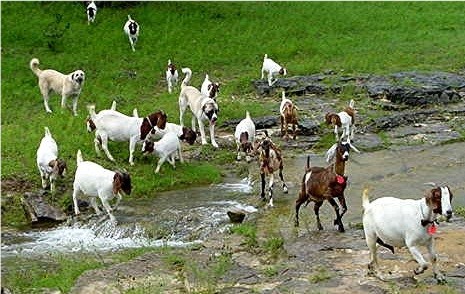 Lucky Hit Anatolians following the flock as the flock moves across the pasture I first notice this very strong bonding trait when pups are as young as four weeks old. Those Anatolians with the strongest bonding urges will leave the puppy pile to snuggle up to their sheep and/or goats. They can also be found when only weeks old in the pasture with their herd rather than lounging or playing with their littermates. Those pups with this early and strong desire to be with their charges translates into adults that are the most strongly bonded to their flock. (Of couse, if you don't raise your Anatolian pups with sheep and/or goats, you have no idea what level of flock bonding each of your pups have and can't select the pup with the greatest likelihood of possessing this superior working trait in abundance!) An Anatolian Breeder I know who breeds true working Anatolians had a young dog who stayed behind with weak stock and lay with them until she came to the pasture. He was especially loyal when they got stuck in the fence. Then he laid right beside them until they came unstuck. This type of loyalty to his sheep and/or goats indicate a very strong level of bonding and is a trait that should always be noticed and bred for. While hip evaluations and other health testing is always important, to me superior working ability trumps every other trait! A dog with superior working ability who has some health problems is a much better Anatolian than one who passes every health test with flying colors and is an AKC Champion but can't be trusted with sheep and/or goats! Of course, having it all is the very best breeding prospect... but without working ability I don't consider the dog a true Anatolian! As Anatolian pups with superior genetically endowed bonding mature, they begin to insist on following their herd as it grazes. Generally, they are seen "following from the front." As the herd move to a new area, the excellent Anatolian is seen moving back and forth in front of the herd's main line of movement, looking for potential predators. However, the moment the herd alters its line of movement, excellent working Anatolians immediately move to the point position again. They are experts at "following from the front." I have designated this trait as "THE FOLLOWING INSTINCT." You can see a picturial display of this working trait by linking to my article, "The FOLLOWING INSTINCT." In some young Anatolians I see what I call "the double edged sword of bonding." The young Anatolian loves its charges so completely that it seems to perceive them as another pup in the litter. Since a weaker sheep and/or goat being played with too roughly hasn't butted the Anatolian pup and doesn't whine or growl, like a puppy would, the young and inexperienced Anatolian loves playing with the kid. The pup believes it has found an ideal playmate! However, the pup isn't learning respect toward the flock. Also, bite control is not being taught by these weaker animals who don't immediately stop the improper play. The owner must either immediately remove the kid or the pup. If the kid is removed and other young goats are present, the pup moves on the the next most submissive animal to play with, so removing the kid generally doesn't work well. I favor moving the pup into a group of dominant adult females. If these dominant females (dominant, not mean) aren't strong enough to stop the play, then move the pup in with dominant adult males. If even that doesn't work, the pup must be placed in a flock-adjacent pen so the pup can see and smell the flock but can't play improperly with them. A pup must not engage in improper and disrespectful play without receiving immediate correction. The owner then must take every opportunity to place the pup in with the flock under the owner's direct supervision at all times. The owner must provide immediate correction and chastisement for any disrespect, no matter how minor. (For me with my genetics, this only requires for me to say the pup's name harshly and point to the pup, who then drops to the ground showing compliance, shame, and regret! Remember, in correctly bred working puppies this is a puppy phase and easily extinguished. It will pass if the puppy is not allowed to learn to enjoy rough play! Of course, if the breeder hasn't been selecting working ability as their primary selection criteria, it may not be so easily extinguished! In any case, the full responsibility for correctly training the pup falls completely on the pups owner!!! I never blame the pup if I've placed the pup in an incorrect environment. I blame myself. By accepting full responsibility, you have the greatest chance for the best outcome! 4. BIDDABILITY While it is wonderful to have a dog that responds to all your commands, like my obedience Doberman did, this type of biddability is incorrect in Anatolians! For thousands of years Anatolians were bred to evaluate each situation and make excellent decisions regarding the action they should take. Once an Anatolian becomes overly biddable, they lose their ability to be independent thinkers. Anatolians must be able to do their jobs without constant human direction. Most of the time they are in the pasture guarding livestock and no human is present for any guidence. Sometimes it seems that a person has an Anatolian that is remarkably biddable. My experience is that this seeming biddability is an illusion. Anatolians do love to make their owner happy. However, in my dogs when push comes to shove, they make the decision their genetics and experience tells them is the correct move. An excellent working Anatolian will reluctantly disobey me if they believe I am wrong! 4. TAIL POSITION AND BODY POSTURE Anatolians use tail position and body posture to signal their sheep and/or goats regarding the presence or absence of potential predators. The greater the skill the Anatolian has in conveying information to their charges, the safer the flock is. When breeding choices are focused on traits contrary to superior working ability, these choices can interfere with the natural communication postures Anatolians have had genetically instilled for millennia. When I was showing my working Anatolians, many judges loved my Anatolians conformation but criticized their posture and demeanor. I understood that these judges might know correct conformation but they clearly did not understand correct breed posture and demeanor. For me, the only aspects of an Anatolian that are "correct" are those that lead to superior working ability. I saw that many individuals showing Anatolians, especially those who didn't need their Anatolians to guard livestock from serious predators, listened to these ill-informed judges and began selecting their breeding Anatolians for these improper behavioral traits the judges preferred. Wouldn't it have been wonderful if all along our ASDCA officials had understood how detrimental this "show advice" was for Breed Preservation! Unfortunately, many of our club officers and board members were deeply involved in the show scene and weren't raising their Anatolians in a working setting. Therefore, they didn't understand that the mis-information being spread by ill-informed judges was harmful to maintaining correct working ability, posture, and demeanor. As a result, they did nothing substantive to correct this misinformation. Perhaps some of them were more concerned about collecting show titles and honors than they were about Anatolian breed preservation! The most common advice given to me from show judges was that I should teach my Anatolians to hold their heads high while in the ring. Poor guardian behavior is seen when an off-territory dog consistently holds its head high, even without an imminent treat nearby. Appropriate off-territory flock guardian behavior is to signal a neutral or submissive demeanor, showing that the Anatolian isn't perceiving or presenting as a threat. This "safe" attitude is signaled when the Anatolian holds its head near back level (sometimes even lower), even while moving. Some off-territory Anatolians may keep their muzzles close to the ground, clearly signaling appropriate "safe" demeanor (imitating grass eating -- a non-aggressive behavior). When an Anatolian wants to signal a lack of neutrality, it raises its head high above back level (as well as holding its tail stiffly upward). Anatolians who consistently hold their heads high when off-territory are not “shut down” and, in my experience, have a greater tendency to behave improperly, generally more aggressively, when off-territory than those Anatolians who appropriately hold their heads level or lower when off-territory. 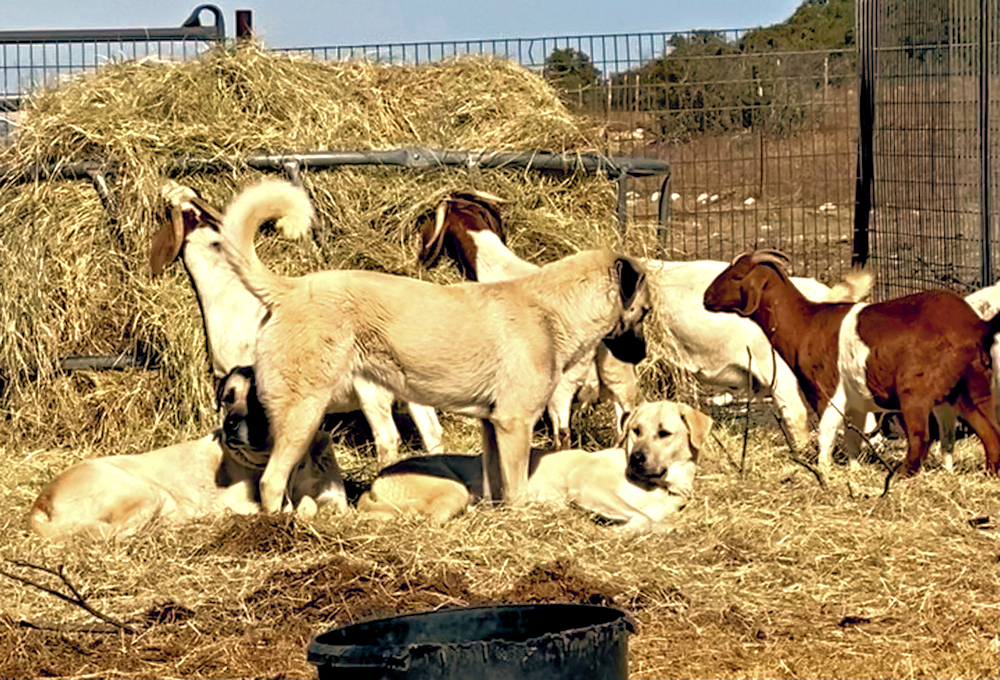
LUCKY HIT Beton SEVAN (SEVAN) January 17, 2021 with her fellow guardians and their goats a week after an unprecidented Texas snow storm. The dogs and goats are enjoying the fact that the Texas winter weather has returned to normal. SEVAN is pictured here as she walks up and dominantly greets her Anatolian friends, LUCKY HIT Behiye TAVIR (TAVIR), female, lying down on Sevan's right and LUCKY HIT Leydi CASE (CASE JR), male, lying down on Sevan's left. SEVAN, like her dam, LUCKY HIT Kamil BETON, is a very dominant Anatolian. SEVAN, pictured here at nine months, holds her tail high as she approachs, demonstrating she is not weak and submissive She is warning the other dogs that she is prepared to take action if they try to subdue her. When the other dogs ignored SEVAN'S presence, her tail dropped and she laid down with her agreeable friends. When an Anatolian holds its tail in the above fashion, the Anatolian is signaling its dominance and, depending on the response of the other dog, its willingness to either be friendly or to fight, whichever seems necessary. When my Anatolians raise their heads high they are on-territory, on alert, looking for a predator, and/or clearly signaling their readiness to take all necessary action. When one of my dogs is off territory and raises its head high, it is signaling that it believes an imminent threat exists and it is prepared for conflict. This is not a signal I feel comfortable seeing Anatolians display off territory, especially in the show ring. Sheep and goats automatically understand these head and tail carriage postures and react appropriately! Let's hope that over time our AKC judges can learn to understand the importance of correct Anatolian head and tail posture with the same level of understanding seen in our sheep and goats!!! 5. DEDICATED TO WEAK, HELPLESS, SICK, AND INJURED ANIMALS Anatolians with extraordinary working ability show a high level of dedication to weak, helpless, sick, and injured animals. If one of their flock is so sick or injured it doesn't or can't return to the barn with the herd, the truly superior Anatolian will remains with that animal in the pasture, even passing up "supper" so they can protect the incapicated animal. At least half a dozen times during his thirteen and a half years lifetime, my incredible working male, LUCKY HIT Shadow Kasif (CASE) remained in the pasture rather than coming in with the flock. Knowing how dedicated he was to his charges, I always worried when they returned and he didn't. I would halter one of my horses and began searching the pasture. Each time I found him a short distance from a newborn kid whose first time mom had moved on with the herd rather than stay the night in the very dangerous big pasture with her weak kid. CASE, of course, had the opposite reaction. Knowing the kid wouldn't make it to dawn alone, CASE lay down protectively near the kid! As soon as I picked up the kid and started riding back to the barn, CASE hopped up and joined me. My line has had numerous dogs who were able to display this level of concern for their charges. For example, a pup from the first Anatolian litter I ever bred, LION, showed his dedication to his charges many times. Once, when a goat's foot was caught in the "V" of a tree, CONARD'S Golden LION (LION) refused to leave the goat, even to come in for supper. Knowing something was wrong, I looked for LION everywhere. I finally found him near some young trees with one of his goats hanging from the "V" of the tree. The goat was large and it was difficult to lift him and release his leg. Finally, when I did, the goat couldn't put any weight on its leg. It must have been hanging there for hours, but LION lay beside the goat calmly waiting for me to fix the problem. We all slowly returned to the barn together, LION clearly showing a great deal of concern for his injured goat! 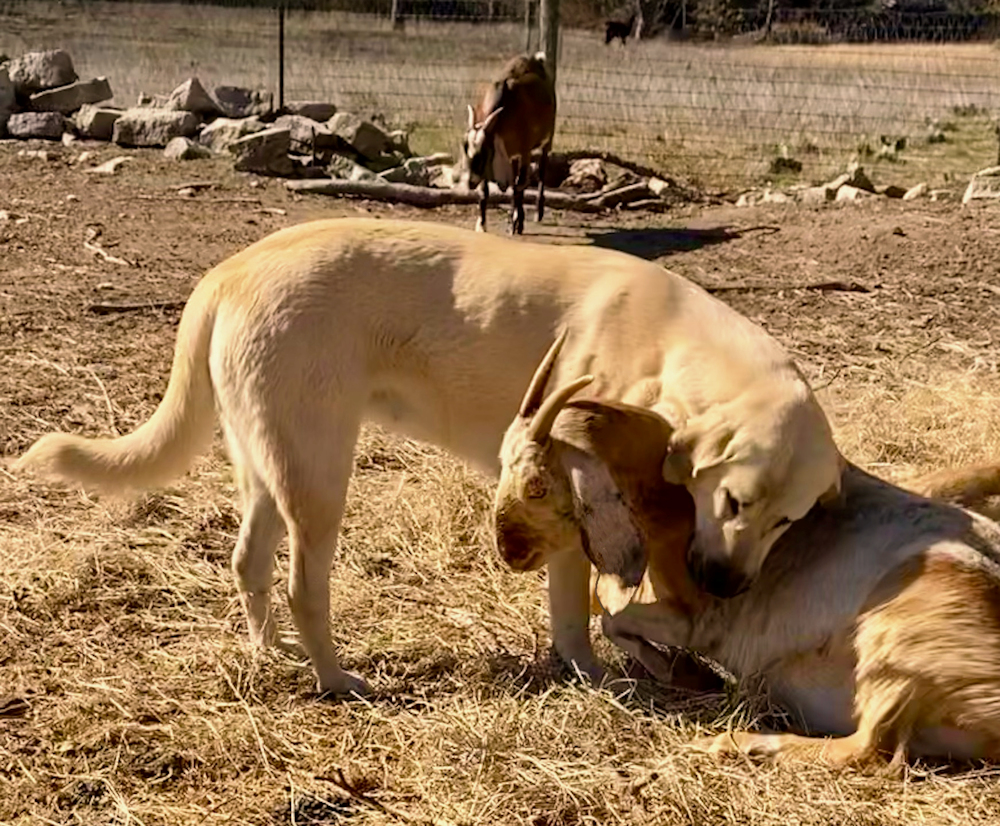 LUCKY HIT Behiye NADIR of ELKHORN (NADIR) LOVING ON ONE OF HER GOATS While this goat is not weak or sick, NADIR dearly loves her goats and is happy to express that love with a hug! Another interesting form of Anatolian dedication to the flock was seen in my incredible male, CHAMPION Birinci's YAHSI of LUCKY HIT (YAHSI). YASHI is the sire of NADIR, the Anatolian female pictured above "hugging" her goat. YAHSI was always an observant, vigilant, and dominant guardian. If any of my goats were sick or weakened, he became noticeably concerned and hyper-vigilant, watching over them until the problem resolved and they could return to the herd. He moved around the sick animal's area, clearly checking for predators at the perimeter by checking for their smell and looking into the distance for lurkers. Then YASHI quickly returned to the sick animal. YASHI then carefully checked over the goat, sniffing to understand the goat's condition, constantly lifting his head to look around quickly in case a predator was sneaking up to attack his sick animal. While YAHSI was always an excellent and observant guardian, with sick animals and newborns he went into overdrive! Nothing was going to get an animal under his protection!!! 6. SUPERIOR INTERACTIONS WITH BIRTHING DOE AND NEWBORN KIDS One of the most important working traits required in a flock guardian is superior interactions with a birthing sheep and/or goats and their newborns. An excellent Anatolian watches from nearby as a goat or sheep is kidding or lambing. When the kid is born, the Anatolian cleans up the afterbirth and fluids where the kid was born. If the kid dies, the Anatolian must eat the dead kid to keep predators from lurking near the herd. 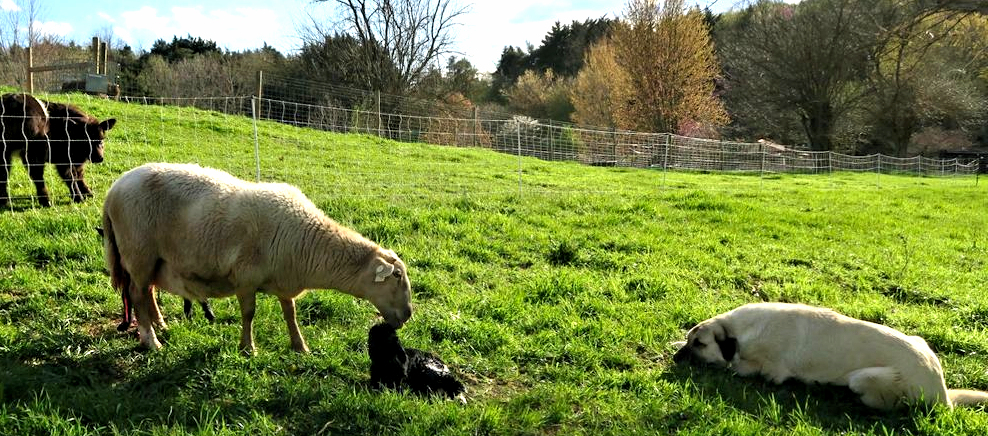 An Anatolian at CEDAR RISE Anatolians watching over a sheep giving birth Another incredible pup from my first litter was CONARD'S TAWNY KAT (TAWNY). When TAWNY was six months old I introduced TAWNY to her first newborn kid. TAWNY'S reactions were perfect! In response to the nervous mother's first aggressive move, TAWNY immediately fell to the ground. This caused the goat to became calmer. Slowly but with great eagerness and desire, TAWNY crawled toward the wet newborn. This approach increased the aggitation of the nervous mother, who reacted with an even more aggressive head posture. TAWNY rolled flat on her side, maintaining the lowest profile possible. When TAWNY was almost at the kid, the agitated mother began aggressively butting her. TAWNY remained completely passive under this somewhat violent assault until the mother backed off, never once making a single aggressive move toward the nanny. As the nanny calmed, TAWNY slowly crawled the last few feet toward the newborn completely flat on her side. When TAWNY reached the weak, wet newborn, she carefully, gently, licked the kid with great maternal affection. As the kid's mom calmed down, Tawny stood immobile above the newborn, trembling with eagerness and exaggerated caution as the newborn nuzzled her in an attempt to nurse. When the kid moved to the nanny, TAWNY did nothing to interfere but continued watching with total love and affection. All these excellent behaviors are only found in the most valuable and superior working Anatolians. These superior working behaviors can ONLY be maintained when breeders place working ability as their primary breeding selection criteria. If Anatolians are selected for traits and behaviors other than working ability, as many show-only Anatolians are, superior working ability will be decreased and eventually lost! This is especially true since many of the traits I've seen show breeders and show judges looking for in the show ring are antagonistic to excellent working ability! Also, without observing Anatolians over time with sheep and/or goats in a predator rich environment it is impossible to know the nature and depth of workiing ability of the Anatolians being selected for breeding. A somewhat different situation occurred with one of my more recent young Anatolians who had been raised in a home/companion situation and then brought here at Lucky Hit Ranch when she was about 14 months old. She is LUCKY HIT Sonra DEVAKIZ KALECI of CEDAR RISE (KIZI). As a home companion guardian, KIZI had no experience with livestock. Trusting her superior working genetics I "threw her in the deep end" by quickly placing KIZI with goats, and then with geese. She acted as if she'd been raised with them. As a more advanced test, I placed a goat who was near kidding in KIZI's pasture. When this goat began kidding, KIZI positioned herself nearby and quietly watched the goat kid. She was fascinated and did not interfere or cause any disruptions to the process. After the kid was born, KIZI continued watching with fascination as the newborn stood and then nursed. After about an hour, after the afterbirth had been expelled and the mom and newborn had moved off a bit, KIZI got up and cleaned the afterbirth and fluids. KIZI stayed quite close to the newborn for several weeks and the newborn loved and played with KIZI. (KIZI also lives and protects about 30 Pilgrim Geese beautifully!!!) Only when an Anatolian has been selected for generations for superior working ability would I expect this level of working ability in a year and a half old Anatolian not raised with livestock! Clearly this is another reason that all responsible Anatolian breeders select superior working ability as their primary selection criteria!!! 7. STRONG DESIRE TO RETURN TO THEIR FLOCK QUICKLY When a predator is chased away from the flock, it is important to note which Anatolians return to the flock relatively quickly and/or aren't drawn too far away from the herd. Those Anatolians who chase predators too far to return quickly or stay away from the herd too long are leaving the flock unprotected from smart predators, who might send a pack member to one side of the herd to lure away the guardian and while the rest of the pack slips in on the other side of the flock for some easy prey. This strong desire to return to the flock quickly is highly desirable for all working Anatolians. It is vital to test for this trait in all breeding Anatolians or, as with all working traits not tested for and not selected for, this essential working trait will be lost over time. All responsible Anatolian breeders, breeders involved in BREED PRESERVATION, are testing their breeding Anatolians for this very important trait and will be happy to discuss with you how they have selected for this highly desirable trait when you are looking for an excellent Anatolian puppy. When my Anatolians manage to make it off the property chasing a predator, the culprits they are chasing are generally the prolific wild pigs found everywhere. These dangerous wild pigs lift up the bottom of the field fence, creating a fence tunnel in and out of the property. When all the pigs have been run off my property, and only then, my dogs follow the pigs through the "tunnel" and into the underbrush. About 15 to 30 minutes later, the dogs re-appear looking for a way back to their goats. Many times they go to the nearest gate and sit there patiently waiting for me to let them back in. Of course, in adjacent pastures I have other dogs which will sound the alarm if any predator unexpectedly appears. Upon hearing this alarm and without waiting for my help, the "missing" dogs return and go over, under, or through the fence in order to return to their vulnerable animals. 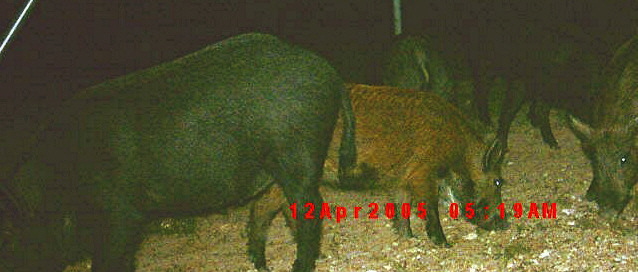 Picture of wild Pigs on Lucky Hit Ranch taken with a game camera Wild pigs are very dangerous, especially in large pig packs. They swarm their prey to bring it down. They are vicious killers. A woman not far from the Houston area was killed attempting to walk about 30 feet from her car to the door. Another superior working Anatolian I had who returned quickly after chasing off a predator was CHAMPION Inanna BETHANY Bay of LUCKY HIT Off my property and outside and above BETHANY'S small pasture the woods stopped near the ridge. Bethany protected some of my goats, geese, and ducks. While BETHANY easily spotted the predators lurking at the edge of the woods, I rarely saw them. Initially, BETHANY barked a warning bark for them to leave. She gave them about ten minutes. That was all the time she was willing to wait. Then, if they were still up there, she stopped barking. Running toward my six foot high gate, she'd fly over the top, run uphill, and drive whatever it was away. She was never gone long. In about 15 minutes she'd return and wait patiently by the gate watching her animals. Only Anatolians with a perfect blend of muscularity, angulation, and correct proportions have the conformation to easily clear a six foot fence! 8. STOIC PERSONALITY WITH GREAT RESISTANCE TO PAIN Excellent working ability requires an insensitivity to painful physical sensations. This insensitivity allows the Anatolian to be able to continue protecting while engaged in serious fights with serious predators. A simple example of the importance of stoic insensitivity is the removal of porcupine quills from your Anatolian's mouth and muzzle. (Stoic insensitivity AND a trusting relations are BOTH required if you plan to remove the quills yourself.) The dog pictured below with porcupine quills (BLUE - from another Anatolian Breeder - not Lucky Hit) was raised here at LUCKY HIT RANCH and went to Arizona when he was four. BLUE found the a porcupine in Arizona. You can read BLUE'S interersting story at DOUBLE DOG DARE, By David Heininger. 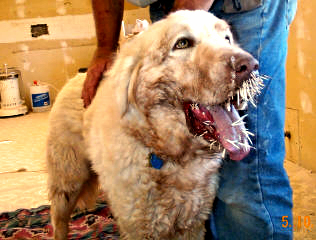 Pictured above is "BLUE" We have had about half a dozen porcupine "attacks" in the last 25 years here at LUCKY HIT RANCH. Really easy ones had only about 30 quills. The medium number of quills I've removed is about 125 per dog. Based on the shear number of quills in the Anatolian, my most difficult quill removals were with LUCKY HIT'S Shadow Kasif (CASE) and CHAMPION Ashley Manor's DIVAKIZ OF LUCKY HIT (KIZZIE). CASE had about 650 quills and it took about three and a half hours with a pair of needle nose pliers. KIZZIE had about 1200 (I lost count!) and it took at least four and a half hours. Before I began the quill removal I examined the best ways to attack the problem. I noticed the tongue area had the least concentration of quills. Talking soothingly and lovingly the entire time, I removed about 20 quills from the center of the tongue. This opened up a quill free area of each dog's tongue. I could see by their expressions exactly when each dog understood that I wasn't just messing with the quills but actually removing them. Once they understood I was really helping them, as I continued talking with all the loving sympathy I could wrap around my voice, each Anatolian tried to remain as still and compliant as possible. The degree they cooperated with me in the quill removal was unbelieveable! Stoic as they are, I know it must have actually been painful. It was late at night when I removed CASE'S quills and after about three hours, to my great amazement, he started snoring! Without the bond of trust I have with my dogs, I know they would not have allowed me to remove even one quill while they were conscious! I am aware of the importance of this stoic nature of Anatolians because my first Anatolian EBLING'S KASIF (CASY) had genetics not long out of Turkey (seven of his parents eight grandparents were born in Turkey), and CASY seemed totally immune to pain so much so that one of my vets was very concerned that "he had no feeling." He began guarding Conard Farm near Copeland, Texas, in 1985. Brushy Creek, a wet weather creek, wandered in and then out again. We called Brushy Creek "the coyote highway" for obvious reasons! By himself he protected my 140 sheep and goats, my calving cows, my chickens, geese, and ducks. He also protected my neighbor's calving cows from coyotes and the occasionally pig. He was aware my neighbor's property wasn't actually his property, but he could not tolerate anything killing a helpless calf! 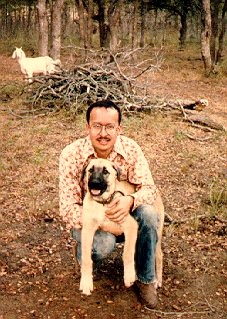 Pictured above is "CASY" with Erick in 1985 at Conard Farm near Copeland, Texas Wasn't he a beautiful puppy!!! CASY's amazing working ability, his stoic and antisocial nature (except toward me), his amazing intelligence, his deep love and dedication to his sheep and goats, his incredibly genetically instilled understand of how to handle hundreds of different working and protection situations correctly, and his intense loyalty for me all worked together to insure that I fell into love with the truly Exceptional Turkish Guardian, the Anatolian Shepherd. Every LUCKY HIT ANATOLIAN can trace its genetic lineage back to my amazing EBLING'S KASIF (CASY)! |
Erick Conard's Address and Phone Number Information
in a New Window
Erick's Address and
 Phone Numbers Link
Phone Numbers Link
|
There is only one way for a breeder to actually understand the working ability of their potential breeding Anatolians... by watching their dogs throughout their lives living with sheep and/ or goats in a predator rich environment! Anatolians who have not been tested for working ability in a real world guardian situation might be tested for every potential genetic problem in the breed and may even have top Conformation awards. However, without being tested for actual working ability the level and types of working ability of the Anatolian cannot be known! Therefore, if that untested Anatolian is bred, the breeder is just throwing the dice and HOPING for a good outcome. In some cases, the "breeder" doesn't even care whether or not the Anatolian has working ability just as long as the Anatolian has a temperament that makes it easy to show. (Excellent working temperament tends to increase the difficulty in successfully showing Anatolians!) Working ability is the defining essence of this breed. Only breeders willing to do the very difficult and time consuming work of raising their Anatolians in a true working environment can be designated as Anatolian Breed Preservationists! |
|
I hope you found my ideas about WORKING Anatolian Shepherd Guardian Dogs interesting and useful. I strive to provide insight into the temperament and character of good working Anatolian Shepherd Guardians by sharing my thoughts regarding how to select the very best Anatolians. I believe in BREED PRESERVATION, which requires using superior working ability as the primary selection criteria! If you are having working problems with your Anatolian, please feel free to contact me for assistance. |
|
ADDITIONAL THOUGHTS: The most important factor when purchasing and raising an Anatolian to guard livestock is to select your pup from two proven and superior working Anatolians. Good or bad working behaviors are inherited, just like good or bad hips, good or bad teeth, etc. Your pup has the greatest likelihood of having superior working ability if he/she comes from two superior and proven working parents. Before purchasing a pup you should visit the ranch and carefully observe the parents to verify that both sire and dam live and work 24/7 with sheep and/or goats in a predator rich environment. Check out the parent's behaviors for excellent and desirable interactions with their sheep and/or goats. If you don't like the parent's behaviors you might not like the puppy's behaviors! Breeders who tell you "all Anatolians have good working ability" are probably just trying to sell their pups, since there is a wide variation in working ability depending on the working genetics of the parents! My experience is that when a breeder has failed to focus on superior working ability as their top breeding requirement, it is possible that the pups they are producing may not have the high level of working ability that you require! |
Erick Conard's Address and Phone Number Information
in a New Window
Erick's Address and
 Phone Numbers Link
Phone Numbers Link
 Click Picture to Return to Anatolian Main page
Click Picture to Return to Anatolian Main page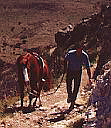 Click Picture to Return to Lucky Hit Main Home Page
Click Picture to Return to Lucky Hit Main Home Page